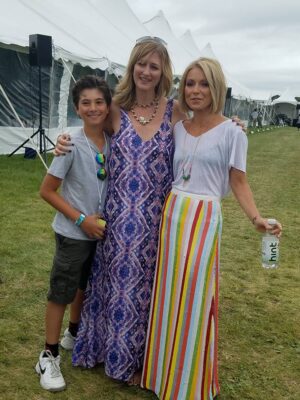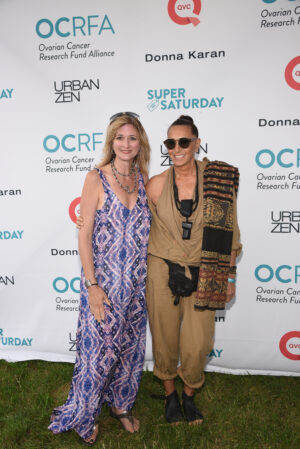
Over the phone, Audra Moran”™s voice percolates with warmth and enthusiasm. The Dobbs Ferry resident ”“ who lives in the Hudson River village with husband Joe Sampino, director of engineering at DirecTV; son Holden and three cats ”“ is a super-volunteer. She”™s been a support service provider for deaf-blind people, a volunteer at the Harrison-based National Multiple Sclerosis Society”™s walks, board vice president for the Yonkers Committee for Smart Development (YCSD); board secretary for the Cure Alliance for Mental Illness Inc.; and head of the biannual clothing event for Spring Community Partners in Dobbs Ferry.
As if this weren”™t enough, she writes murder-mystery plays, sending friends their parts via email to enact at her home. Clearly, she”™s a woman who knows how to spread joy, perhaps in part because she has a serious job helming an organization dedicated to one of the most insidious and lethal diseases ”“ ovarian cancer.
“Unfortunately, it”™s detected so late, and there is currently no effective screening for ovarian cancer,” said Moran, president and CEO of Ovarian Cancer Research Alliance (OCRA). Incorporated in 1994 as Ovarian Cancer Research Fund, OCRA is the oldest and largest ovarian cancer philanthropy in the world, dedicated to funding for research, support for patients and family and advocacy in Washington, D.C. before Congress and the National Institutes of Health (NIH). (In 2016, the fund merged with Ovarian Cancer National Alliance to become OCRA, with offices in Manhattan and Washington, D.C.)

Joining the organization in 2010, Moran has overseen the merger and OCRA”™s passing the $115-million mark in research funding. Its peer support for women in treatment for gynecologic cancers is in 30 hospitals and has expanded nationally and internationally through a highly successful virtual program. Its survivor-led training program reaches more than 13,000 medical students annually. And a newly launched patient support program is already serving thousands each year.Most recently, Moran has spearheaded the evolution of OCRA”™s role in advancing research progress and drug development by establishing the organization as an international convenor to promote crucial research collaborations and data-sharing.
Such efforts are critical for what is the deadliest of the five gynecologic cancers (which include cervical, uterine/endometrial, vaginal and vulvar cancers). With a five-year survival rate of 50%, ovarian cancer is expected to claim the lives of 13,270 women this year, according to the American Cancer Society. “One in 78 people with ovaries will get ovarian cancer,” Moran said.
Part of the problem is that ovarian cancer is a stealth disease. Seventy percent of cases develop in the fallopian tubes. Such symptoms as bloating, a feeling of fullness, difficulty in urination and pelvic pain can be signals of other illnesses or nothing at all, though their persistence should be followed up, she added. There”™s no real screening for the disease. By the time it becomes apparent, it”™s usually well-developed and may have even metastasized.
Despite this, the number of new cases has been decreasing over the years from around 22,000 to a projected 19,710 this year. “The protective effect of birth control is one theory” on the decline, Moran said. Another is greater awareness of parents”™ family history, including the presence of the BRCA1 or BRCA2 gene mutations ”“ which increases the risk of getting breast, ovarian, prostate and pancreatic cancers.
The presence of a defective BRCA1 gene led actress-activist Angelina Jolie, whose mother, a breast cancer sufferer, and grandmother both died of ovarian cancer, to have a preventive double mastectomy and reconstructive surgery in 2013. Two years later, she underwent a laparoscopic bilateral salpingo-oophorectomy to remove both ovaries and fallopian tubes. In 2021, tennis player-commentator Chris Evert underwent a preventive hysterectomy and bilateral salpingo-oophorectomy a year after her sister, Jeanne Evert Dubin, died of ovarian cancer and Evert discovered they both had the same BRCA1 variant. It turns out Evert had Stage 1 ovarian cancer. She is cancer-free but underwent a preventive double mastectomy last year.

About 20% of ovarian cancers are genetic, and OCRA provides free genetic test kits to those at risk.
As for other possible causes, Moran said the scientific data is actually incomplete on whether talcum powder products generate ovarian cancer ”“ which hasn”™t prevented manufacturer Johnson & Johnson from having to hand out millions in lawsuits. (On May 19, 2020, the company, still facing some 38,000 related lawsuits, announced it would no longer sell talc-based baby powder. On July 28, a court denied Johnson & Johnson”™s attempt to use a bankruptcy case to limit liability in the still pending suits. For those who like baby powder, some gynecologists have recommended the pure cornstarch variety for adult use.)
For those not at risk of ovarian cancer, there are few preventive options, but Moran said that an opportunistic salpingectomy ”“ in which the fallopian tubes are removed during other pelvic surgery ”“ is a possibility.
Born in the U.S. territory of Guam, where her father was in the Navy, and raised in Lakeland, Florida, Moran has long been interested in helping others through health care. She holds a Bachelor of Arts degree in psychology and a Master of Arts degree in rehabilitation and mental health counseling from the University of South Florida. Moving to New York after graduation, she worked with deaf-blind adults at the Helen Keller National Center in Sands Point, named for the Easton resident who became an international lecturer, author and activist despite having gone blind and deaf at age 19 months due to an illness, possibly meningitis. Moran became fluent in American Sign Language (ASL), as well as a Certified Rehabilitation Counselor (CRC) and National Certified Counselor (NCC). It was at the center that she met her husband.
After seven years, she moved over to the National Alliance for Research on Schizophrenia and Depression/NARSAD (now the Brain and Behavior Research Foundation) where she remained for the next 11 years. Eventually, she segued there from working one on one with those who have mental health issues to exploring her talents for fundraising and administration as vice president of development and scientific affairs ”“ talents she now calls upon as she helps others understand the mysteries of ovarian cancer.
For more on Ovarian Cancer Research Alliance (OCRA), click here. ”¯





















